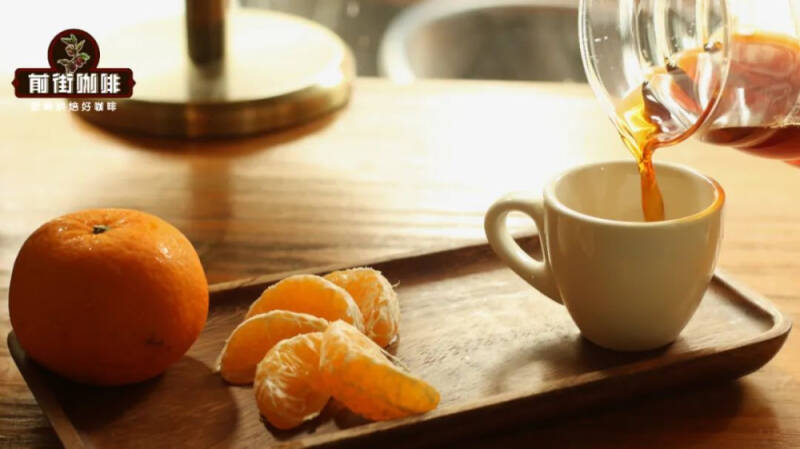Where does the fruity flavor of coffee come from? Why is the citrus and berry flavor of hand-brewed coffee so obvious?
Citrus, passion fruit, strawberry, grape. We have known the taste of these fruits from an early age, and even if we are blindfolded, we will know which kind of taste it comes from. Combined with the taste brought by chewing, it is not surprising to refine it to a more specific branch. For example, we can tell whether it is sugar orange, mandarin orange or navel orange from citrus.

But when it comes to coffee, we are often surprised by the richness of these fruits and why they appear in this drink. After all, in my impression, isn't it from the black beans that are ground and flushed? What does it have to do with these fruits?
Coffee is essentially a kind of fruit. Different planting places, varieties and climatic factors will affect its quality and taste. Many friends know this. But in fact, most of the fruit aromas are not generated at the beginning, but are transformed in a very short ripening period, which is why more and more farmers are required to pick only all-red fruits. The aim is to pursue the fuller sweetness of coffee.

During the growth stage of the fruit, carbohydrates are stored in large quantities in the cells in the form of starch grains, and the enzyme system responsible for providing invertase is ready to take effect. At the ripening stage, the decomposition of carbohydrates will increase sugars (such as glucose), soften the texture of the fruit, and produce many ester and carbon-based aroma substances.
The same goes for coffee. 60% of each raw bean is carbohydrate, 10% is protein, 10% is fat, and some chlorogenic acid, caffeine, fenugreek salt and other ingredients. To make coffee taste "fruity", in the final analysis, it contains many aromatic substances similar to fruit aroma, most of which are esters, ketones and alcohols. For example, fatty acids, mushroom alkenes, amino acids, and so on, are all sources of fruit aroma that have long been stored in raw beans.
I do not know if you have ever smelled coffee raw beans, it is not the charming coffee aroma we usually smell, not to mention a variety of attractive fruit flavor, Qianjie thinks that it only has a faint smell of grass and cereals.
In fact, the coffee aroma substances mentioned on the front street are stored in raw beans in a stable form, or in a "hidden" state, and baking is the key to transforming them into volatile aromas. and this is mainly due to the Mena reaction and the caramelization reaction.
After being heated to a certain extent, coffee raw beans begin to undergo complex degradation and polymerization. Reducing sugars such as amino acids, glucose, fructose and lactose that make up proteins in raw beans continue to form aromatic compounds in the process of continuous heating. In this process, more than 600 volatile aroma compounds are produced in the coffee beans.
With the superposition of reaction time, coffee first forms fresh floral and fruity notes, followed by thick nuts, fermentation tonality, and finally caramel compounds, but at this time the aroma of flowers and fruits is gradually disappearing. This also explains why it is difficult for us to drink flower-and-fruit flavor from deep-roasted coffee beans. if we pursue flower and fruit flavor, it is best to choose coffee with medium / light roasting degree.
Of course, the medium / shallow degree of roasting not only affects the conversion of light aroma substances, but also determines the higher content of various organic acids (citric acid, malic acid, lactic acid) in coffee, that is, the brewed coffee will be in the category of "acid".
Brewing is the last step of flavor expression. In the process of seed selection, planting, processing, roasting and brewing of a cup of coffee, the upstream link will have a greater impact on the coffee flavor, while the downstream brewing has relatively little effect on the coffee flavor. Under the sense of smell and acidity caused by various fruit-or flower-scented compounds, our brains associate this experience with the moment when we remember eating a fruit.
-END-
Front Street Cafe
No. 10 Baoqian street, Yandun road, Dongshankou, Yuexiu district, Guangzhou, Guangdong province
Important Notice :
前街咖啡 FrontStreet Coffee has moved to new addredd:
FrontStreet Coffee Address: 315,Donghua East Road,GuangZhou
Tel:020 38364473
- Prev

Why does Qianjie always use three-stage coffee brewing? Where is the advantage of three-stage water injection compared with one-cut water injection?
So far, the extraction of hand-brewed coffee has given rise to countless brewing methods! Such as a knife flow, four or six rush, volcanic rush, Kono style cooking and so on, a variety of different cooking let us have more fun. But it so happens that Qianjie focuses on three-stage cooking! I believe this is what many friends will feel.
- Next

Outrageous! The packing cup is cracked! Tims publicly apologizes!
Related
- Being chased out of the rain in front of Starbucks?! Store: Sheltering from rain under umbrellas poses a safety hazard
- The white moonlight has changed?! Lucky launches "Big Winter Pear American"
- Hand-brewed coffee three-stage method, high-sweet and universal brewing method to share! What does the high sweet water level of hand-brewed coffee mean?
- What is the difference between raw, refined and full espresso coffee? How to extract espresso and taste good?
- A complete list of coffee bean names and their meanings! What is Yejia Shefi coffee? Where is Mantelin coffee?
- What grade does Arida Manor Kaduai coffee beans belong to? What treatment is Arida ASD slow anaerobic sun exposure?
- The milk tea cup becomes smaller?! Overlord Tea Girl launches a new "Return to Yunnan" series
- Accused of selling counterfeit and high-priced coffee beans! Well-known boutique coffee brand "Oukelao" bowed and apologized!
- How to make espresso dumplings? Can I eat coffee and glutinous rice balls together?
- Save the unformed and stagnant powder cakes in one second! What is the problem with stagnant water in the powder bowl of the espresso machine?

